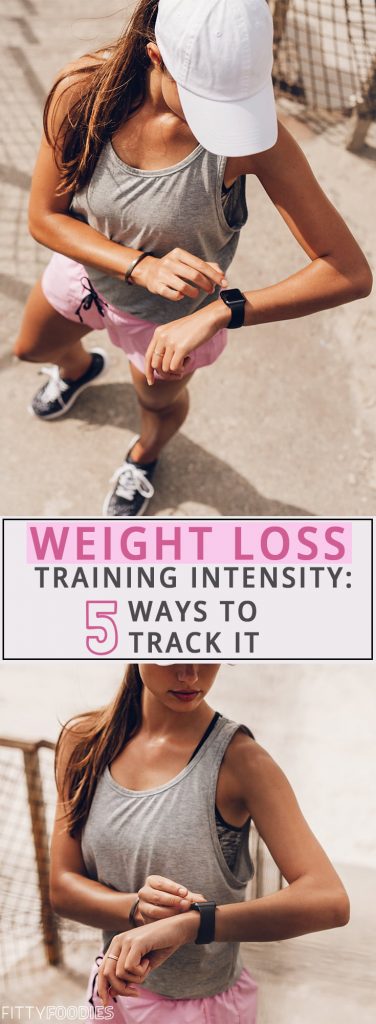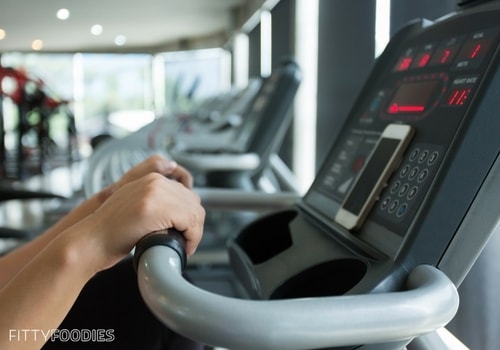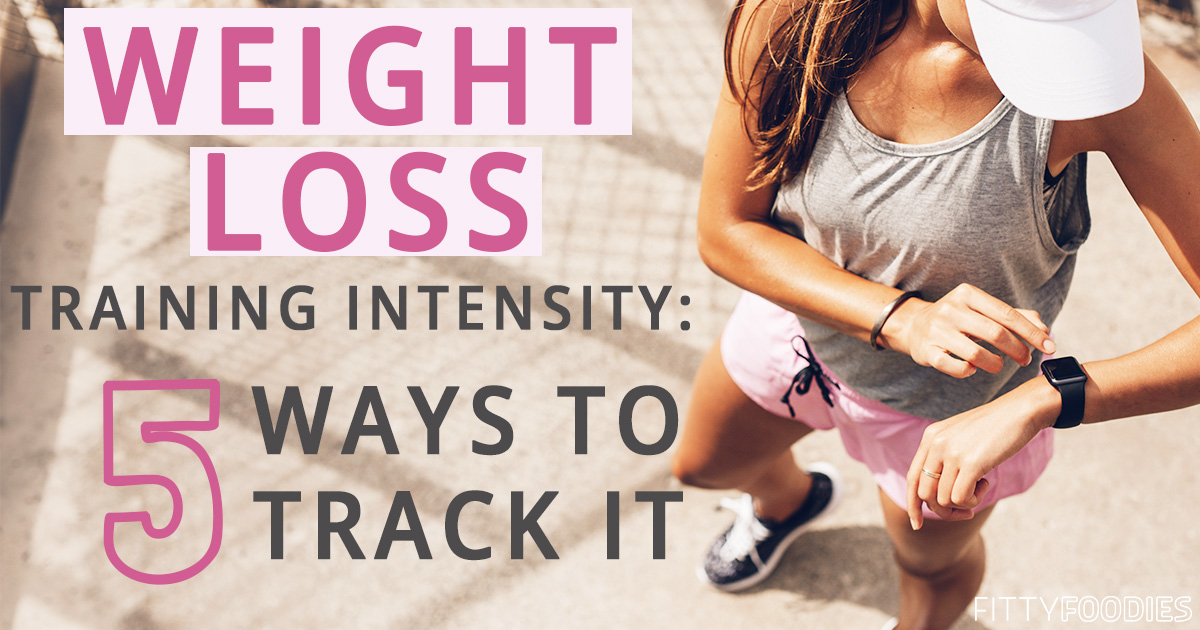This post may contain affiliate links. For more info please read our disclosure.
 You may be wondering why tracking your training intensity is important? Well, let me tell you – there are different intensities, depending on your goal. For example, if your goal is to increase your fitness performance you should train at a high intensity, but if your goal is to burn fat, you should train at a light intensity. Therefore, when losing weight, it is very important to track your intensity, so you wouldn’t be wasting your time and losing weight as efficiently as possible. In this post, I will review 5 ways to track weight loss training intensity.
You may be wondering why tracking your training intensity is important? Well, let me tell you – there are different intensities, depending on your goal. For example, if your goal is to increase your fitness performance you should train at a high intensity, but if your goal is to burn fat, you should train at a light intensity. Therefore, when losing weight, it is very important to track your intensity, so you wouldn’t be wasting your time and losing weight as efficiently as possible. In this post, I will review 5 ways to track weight loss training intensity.
But before we start, make sure you know what your heart rate should be for burning fat, as this is a very individual thing. If you’re not sure, check out my previous article about calculating your own heart rate zones.
1.Talking test
 If you are exercising in the low-intensity zone you should be able to talk fluently. If you can’t say 3 sentences without being short of air, your intensity is too high and you need to slow down. This method isn’t very precise, but it works pretty well if you don’t have any other equipment for measuring your heart rate.
If you are exercising in the low-intensity zone you should be able to talk fluently. If you can’t say 3 sentences without being short of air, your intensity is too high and you need to slow down. This method isn’t very precise, but it works pretty well if you don’t have any other equipment for measuring your heart rate.
2. Measuring pulse by hand
I’m pretty sure everyone is familiar with this method, but if not, feel free to check out this video with the instructions on how to measure your pulse by hand.
[embedyt] https://www.youtube.com/watch?v=TjFgfX3oHuo[/embedyt]
Theoretically, this method should work just fine, but, unfortunately, it’s quite difficult to measure your pulse by hand while exercising. Just try counting your pulse while running or brisk walking…
3. Using Running/Fitness Watch
Personally, I have been using the Polar M400 with Polar H7 Heart Beat Sensor for about two years, and I can say that it does its job very well. This is a very precise method to measure your heart rate, plus it has a lot of features that really help during a weight loss journey. Here’s a nice review about it, if you’re interested:
[embedyt] https://www.youtube.com/watch?v=-_Cux-Lkz6w[/embedyt]
Things I love in Polar M400:
- It has ~2 weeks battery working time (I don’t use GPS and smart notifications).
- It’s waterproof.
- It has activity and sleep tracking
- You can set your own heart rate zones
- It has a very well developed mobile app and web interface
- It has a Fitness Test feature (you can track your fitness level and resting HR)
Things I don’t like in Polar M400:
- You need to sync your data manually
- After ~2 years of wearing it, I see quite a big depreciation in the rubber wristband. The good news is that a new wristband costs only ~20 USD.
Conclusion:
- It has a few minor things that I don’t like, but it really does its job like a pro.
- It’s a very, very high-quality fitness watch.
- It’s an all-in-one solution – it has EVERYTHING you need to achieve your goals.
- If you have the opportunity to buy it – you should buy it. It’s definitely worth the money.
Remember: I never ever recommend products that I haven’t tried and liked myself.
If you’re interested in buying it, here’s where I got it from – take a look and bring your workouts to another level!
4. Activity Trackers
Now you are probably thinking – what’s the difference between a running/fitness watch and an activity tracker? The first difference is the price and second is functionality. While a good fitness watch costs ~ 200 USD and more, you can buy a good activity tracker for ~30 – 40 USD. An activity tracker is a great device for beginners, but if you are very serious about fitness – grab a fitness watch.
Personally, I have tried only one activity tracker – Xiaomi Mi Band 2. Here’s an honest review that I found for you:
[embedyt] https://www.youtube.com/watch?v=QVMf63rdLMw[/embedyt]
Personally, I liked this activity tracker because:
- Very good price;
- Excellent quality, honestly it surprised me in a good way! It feels like a high-class product – I would have never thought that it costs only ~40 USD;
- Long battery life ~ 10 – 15 days depending on features used;
- Very accurate step counter;
- Optical heart rate sensor;
- Well developed mobile app;
- Waterproof;
- A wide range of changeable bands – from plastic to gold. You can check them out here.
Things I didn’t like:
Uh oh, this is hard. I’m sitting here trying to think of something, but I really can’t say anything bad about it! For the price I paid – it had everything I could imagine and much more. Except maybe the charger – this charger isn’t a universal micro USB charger, so if you lose it, you will have to buy a new one (~2-5 USD).
Conclusion:
Even if it would cost twice as much, it would be worth the money! That’s my personal opinion about Xiaomi Mi Band 2.
5. Heart Rate Tracking On A Treadmill With Built-In Sensors
 I used this method at the beginning of my weight loss journey, and it has both positive and negative sides.
I used this method at the beginning of my weight loss journey, and it has both positive and negative sides.
Positive sides:
- Most of the cardio machines have it so you don’t need to buy anything in addition;
- It measures quite accurately.
That’s probably all I can say about the positive side of this method – it works and it’s free.
Negative sides:
- It doesn’t work steadily. If you are sweating heavily (and usually you are if you are training seriously) the sensors start to mess around – “Place hands on the sensors”, “No heart rate”, “Slowing down – no heart rate”. Instead of focusing on training, you are fighting with the cardio machine. It sucks!
- When you go, it stays in the gym. You can’t get your resting heart rate, you can’t calculate your intensity zones, you can’t track your activity and etc.
- It’s uncomfortable. If you want the heart rate sensor to work you must keep both hands on it. If you need one hand, for example, for drinking water, it looses your heart rate.
Conclusion
 It all depends on the level you are in: If you are just starting out, an activity tracker should be good for you. If you are very serious about exercising – go for a fitness watch, it will bring your workouts to another level. If you don’t want to spend a penny on devices – try the talking test or the built-in sensors on the cardio machines.
It all depends on the level you are in: If you are just starting out, an activity tracker should be good for you. If you are very serious about exercising – go for a fitness watch, it will bring your workouts to another level. If you don’t want to spend a penny on devices – try the talking test or the built-in sensors on the cardio machines.
Personally, I recommend starting from the Xiaomi Mi Band 2 activity tracker. Not because I will get a commission from the sale, but because it will help you understand yourself, your activity, your heart rate, your sleep, your body better! It will help you move more and stay motivated. Then, when you “grow” and this activity tracker doesn’t meet your requirements anymore, go for a fitness watch. If you are an experienced fitness enthusiast – go for the Polar M400.
Thank you for reading. I hope that I helped you understand fitness better. If you have any questions, comments or just want to say something – feel free to comment, it means a lot! 🙂

